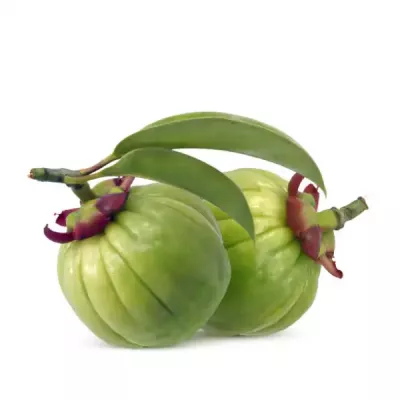



Malabar tamrind or Kudampuli is an evergreen plant known for its fruit which is a popular spice. Fruit is usually dried before use. Hence, it is also known as Thodupuli, Pinarapuli, and Pinatupuli.

Pay using UPI, Card or Netbanking

Shipping within 3 working days
Malabar tamarind, or Garcinia gummi-gutta (Syn. Garcinia cambogia), is a tropical fruit-bearing tree species in the Clusiaceae family commonly known in English-speaking countries as brindleberry.
Vrikshamla, as it is called in Sanskrit, is a major ingredient in ayurvedic medicines in India.
Common names: Malabar tamarind, Garcinia cambogia, Brindleberry, Vrikshamla, Kudam Puli, Kodampuli, Pot Tamarind, Assam Fruit, Gamboge, Fish Tamarind, Malabar Garcinia, Goraka.
Kokum is sometimes used interchangeably with Malabar tamarind. Though they are closely related and have similar health benefits, kokum is botanically Garcinia indica.
Malabar tamarind is used to make food rich, nutritious, and delicious. Curries, especially that of fish are flavoured using malabar tamarind and for this reason, it is called fish tamarind. The culinary use of Malabar tamarind is popular in Kerala and the Konkan region.
Malabar tamarind seeds may be used to produce seedlings that can be used as planting material. But it may turn out to be a male plant that does not produce fruit. This may take up to 10 years to realise!
This problem is solved by producing grafts from very good Malabar tamarind trees. Grafted plants with good care start to bear fruit in three years.
Garcinia gummi-gutta is a slow-growing tree that can reach up to 12 metres in height. It grows well in tropical climates with high humidity and moderate rainfall.
Malabar tamarind grows well on river banks, plains, and hill slopes.
The plant prefers a soil with a pH range of 5.5 to 6.5, which is a slightly acidic soil.
The plant can grow in full sunlight or light shade. It can be grown as a stand-alone crop or as an intercrop in coconut and squash groves.
Dig a pit 75 x 75 x 75 cm deep, fill it with manure, and plant in it. There should be at least 5 metres between the rows.
It can grow in large containers with regular pruning and supplements.
Malabar tamarind trees grown in backyards are seldom irrigated. However, during very dry spells and during fruit setting, it benefits from irrigation.
It is generally devoid of pest issues.
The flowering period is from January to March. It is either plucked when it is well ripened or picked up when it falls down.
The nuts are washed, the soil and dirt are removed, they are split, and the flesh is dried in the sun. It is usually the rainy season during the tamarind harvest. Therefore, ordinary farmers smoke and dry the tamarind. It is better not to use plastic containers for storing malabar tamarind.
Data sheet